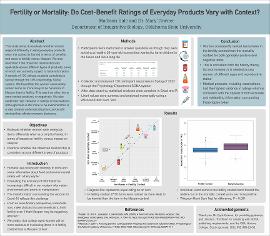| dc.contributor.author | Hale, Madison | |
| dc.date.accessioned | 2022-05-09T14:28:09Z | |
| dc.date.available | 2022-05-09T14:28:09Z | |
| dc.date.issued | 2022-05-26 | |
| dc.identifier | oksd_hale_HT_2022 | |
| dc.identifier.uri | https://hdl.handle.net/11244/335625 | |
| dc.description.abstract | This study aimed to evaluate whether women respond differently in rating everyday products when the context is framed in terms of benefits and costs to fertility versus lifespan. We also examined if the observed relationship was applicable across different types of products, some of which are currently subject to false information. A sample of 130 college students completed a survey through the OSU psychology SONA system. We found that the women consistently ranked items as more likely to be beneficial to lifespan than to fertility. This was true when items were ranked positively or negatively. We also confirmed high variance in ratings of vaccinations. Although there is still more to be examined this is a step towards understanding the cost-benefit mindset that affects women's decisions. | |
| dc.format | application/pdf | |
| dc.language | en_US | |
| dc.rights | Copyright is held by the author who has granted the Oklahoma State University Library the non-exclusive right to share this material in its institutional repository. Contact Digital Library Services at lib-dls@okstate.edu or 405-744-9161 for the permission policy on the use, reproduction or distribution of this material. | |
| dc.title | Fertility or mortality: Do cost-benefit ratings of everyday products vary with context? | |
| osu.filename | oksd_hale_HT_2022.pdf | |
| osu.accesstype | Open Access | |
| dc.type.genre | Honors Thesis | |
| dc.type.material | Text | |
| dc.contributor.director | Towner, Mary | |
| dc.contributor.facultyreader | Byrd-Craven, Jennifer | |
| thesis.degree.discipline | Integrative Biology | |
| thesis.degree.grantor | Oklahoma State University | |
